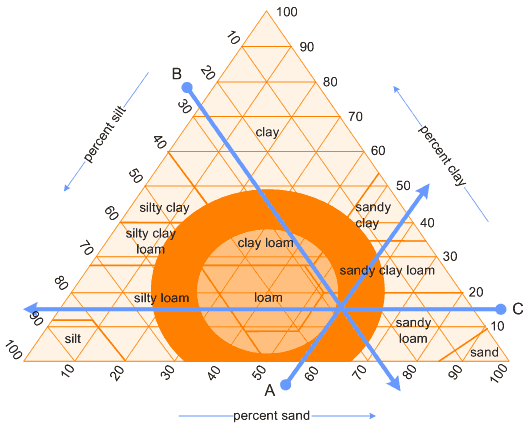Soil moisture testing and your soil’s ability to store water and make it available to the plants you grow is highly dependant on the type of soil you have. There are 3 major non-organic components of soil that affect its texture: sand, silt and clay. Each of these components has a progressively smaller grain size and this affects its physical properties. Sand has a grain size from 0.05mm up to 2mm, silt has a grain size 0.002mm up to 0.05mm and clay has a particle size less than 0.002mm.
The soil texture triangle attempts to classify soil according to its constituent particles. A simplified soil triangle is shown in Figure 1.

Figure 1: Soil triangle classifying soil according to its constituents. Sourced from http://www.landscape-and-garden.com/garden-soil/soil-triangle.aspx
A simple field test to determine your soil type is called the Bolus Test and is widely used as a guide when full laboratory particulate analysis is not available.
Take a small amount of soil in hand. Wet soil to field capacity (just damp). Roll the soil into a ball. Push soil between thumb and forefinger to form a ribbon.
| Sands: |
Little or no coherence and cannot be rolled into a ball. Sand grains adhere |
| Sandy Loams: |
Some coherence, can be rolled into a stable ball and will form a ribbon 15 |
| Loams: | Will form a ribbon 25mm long. Smooth spongy feel with no sand grains |
| Clay Loams: | Ribbon 25-50mm long |
| Light Clay: | Ribbon 50-75mm long. Some resistance to ribboning |
| Heavy Clay: | Ribbon greater than 75mm. Strong resistance to ribboning |
Once you have determined the soil type, the graph in our Hydrosense manual appendix will allow you to determine your wilting capacity and field capacity from your Hydrosense measurements. You can then make some informed management decisions related to your crop.